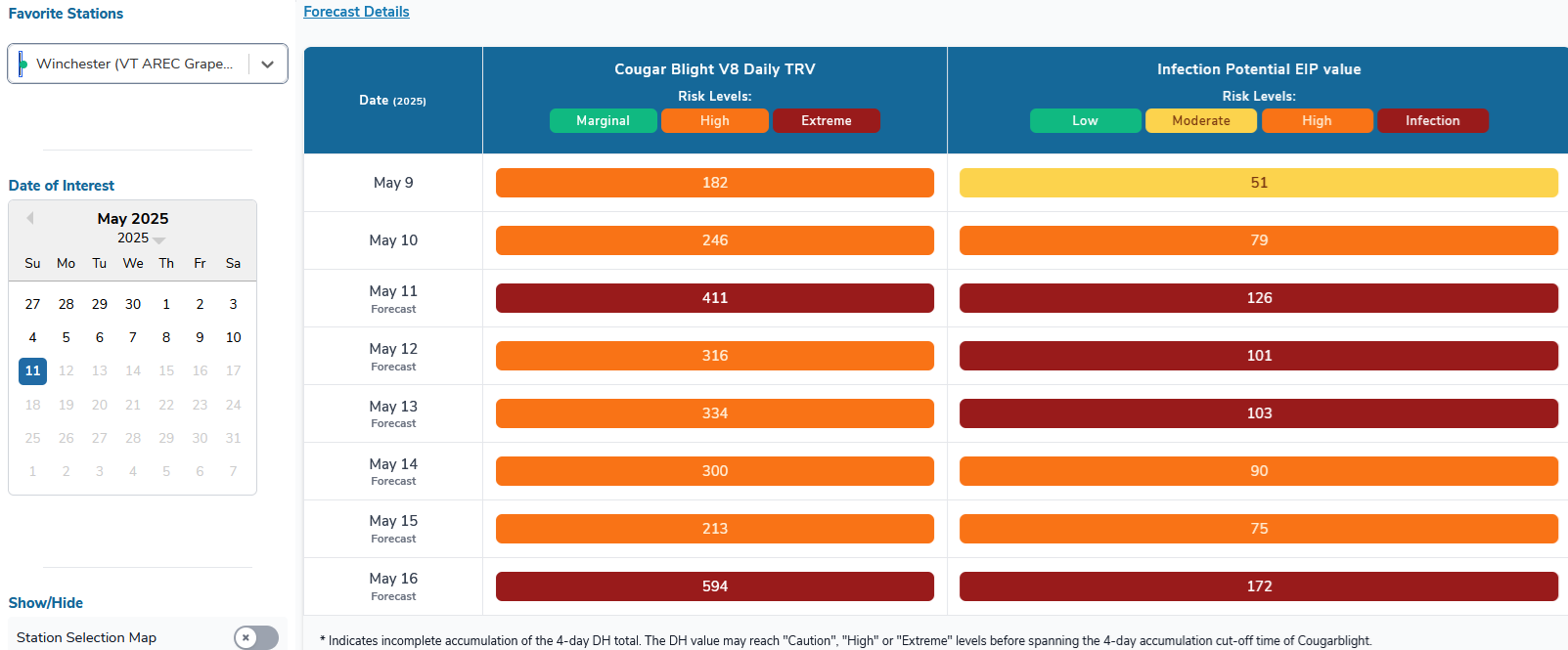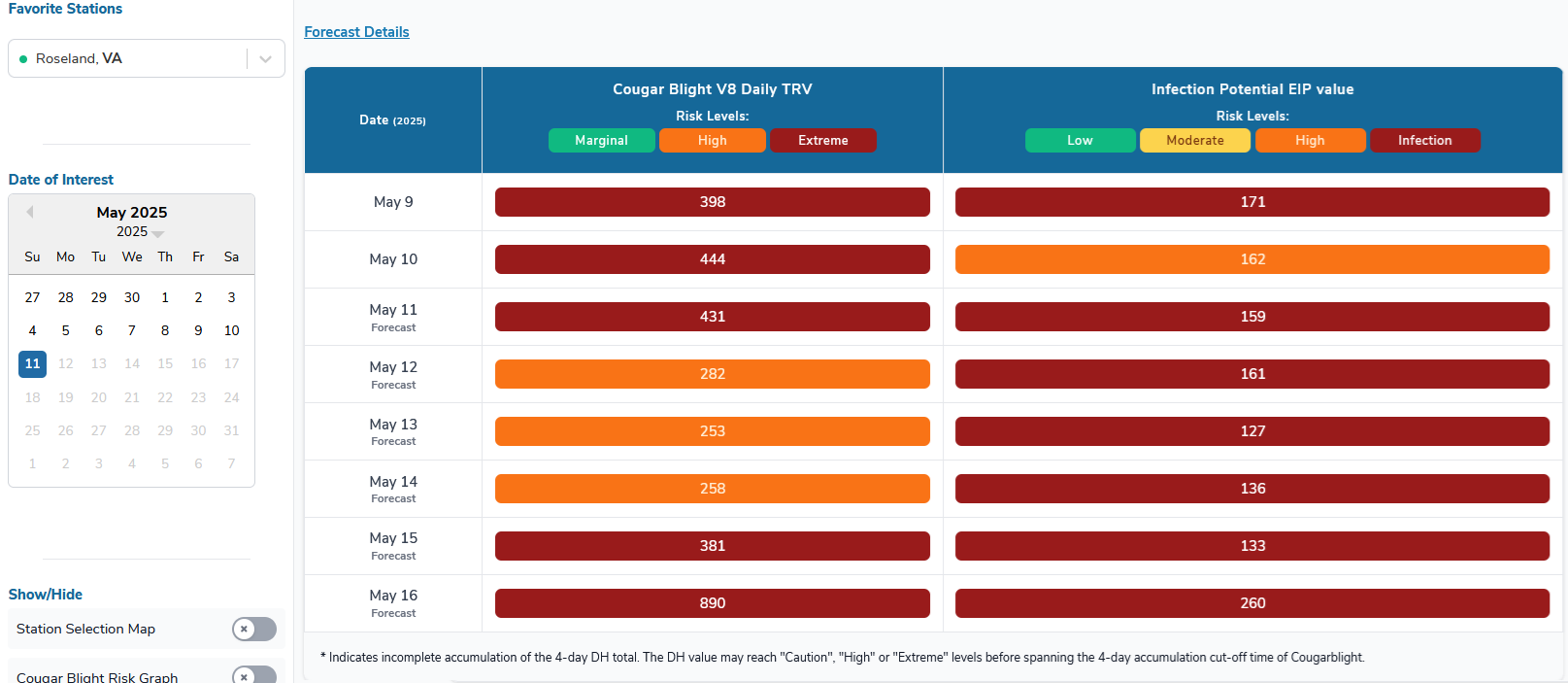(I) Apple Scab Infection Predicted For Rains 11- 14 May; (II) Keep Applying Streptomycin in Cider Apple Cultivars if Flowers Are Still Opening
(I) We are very close to the end of primary apple scab season but we are not there yet. We call the ned of the primary scab season when the apple scab fungus’ Venturia inaequalis ascospore number in the spore bank in the leaf litter on the orchard floor fall’s below 5% (this can be determined easily if you are subscribed and using RIMpro Venturia 3.0 disease model). Due to extremely conducive, meaning wet and cold and then wet and warm weather conditions from mid-March until early May in 2025, we will have one major more apple scab infection from 11 – 14 May as per the current weather forecast which shows a series of rain showers predicted for this period ahead. Once, we reach the day when V. inaequalis ascospore number in the leaf litter on the orchard floor fall’s below 5% I will let you know via this blog. Finally, my recommendation for fungicide selection for this apple infection scab infection ahead is – think about what was it that you applied the last two covers sprays before? If you applied DMI fungicides the last to cover sprays, this oncoming one before the rains of 11 – 14 May could be an SDHI plus mancozeb. Some SDHI-s you can consider are Excalia, Sercadis, Miravis, Fontelis or any other stand alone SDHI material. Manocozeb will be effective for scab and any rust infections during these rains. SDHI will be effective for scab and powdery mildew. If, on the other hand you did not apply a DMI in the previous two cover sprays, I would recommend a DMI fungicide now, before the rains of 11-14 May plus mancozed. Good materials would be either: Cevya, Inspiter Super, Procure, Sonoma, Rally or Rhyme. They will be effective for apple scab, apple powdery mildew and apple rust. Always add a contact multi-site fungicide with your single site fungicides like DMI or an SDHI so as to broaden the specter of efficacy of your tank mix and achieve a thorough kill of the germinating pathogen spores. Finally, use the apple scab infection prediction models – they are the only tool that can indicate to you when the infection will happen with RIMpro providing the added benefit of telling you the actual severity of the infection for each rain event – with it’s RIM value, whcih stands for Relative Infection Measure, it tells you the percentage of ascospores that successfully infected in each rein event. That is critical for selecting which fungicide(s) you will apply. You can read more about that in the article linked here: S. G. Aćimović, A. E. Wallis, M. R. Basedow (2018): Two Years of Experience with RIMpro Apple Scab Prediction Model on Commercial Apple Farms in Eastern New York. Fruit Quarterly, Winter issue, Vol 26 (4), pg. 21-27.
(I) If you have any apple cider cultivars or recently planted trees with rat-tail bloom, yes the rains of 11-14 May will trigger new fire blight infections on those open flowers. You should follow the fire blight EIP infection model in NEWA network: https://newa.cornell.edu/fire-blight/ for your closest weather station and apply streptomycin just before the infection events will be triggered by rain, as per weather forecast. Infections are designated as dark red “Infection” rectangles with EIP values of 100 and above. If you have an orange rectangle indicating “high risk” and the value of EIP is 100 or above, you can trigger the infection with the water from your sprayer – unless you add streptomycin into your spray tank. In an example below, fire blight infections are predicted with rain events 11-13 May in Winchester VA (Figure below). On the other locations, e.g. Roseland VA, there will be a continued block of infections 11-16 May as at this time of the year fire blight cankers are very active releasing fire blight bacterium Erwinia amylovora to infect any new open flowers as the weather conditions are highly conducive for fire blight.


SPRAY OPTION 1: spray preventive streptomycin – cover 24 h or less before the predicted wetting event any apple and pear trees in bloom with streptomycin: Harbor, or Agri-Mycin 17 WP, or Fire Wall 17 WP at 1 to 3 lb per acre (16 – 48 oz/A) plus LI 700 at a penetrating rate or use Regulaid instead of LI700. Based on the Regulaid label, you could use 2 pints penetrating rate. New formulation FireWall 50WP has the rate of 8 – 16 oz/A. If rain does not occur and EIP is 100 or above, while field is orange color, you can trigger the infection if you provide water with a fungicide spray application, so if you are applying a previously planned fungicide application – add streptomycin to it. Option one is a must in large acreage apple and pear farms. You can add your fungicides to streptomycin to make the spray more economical, and keep the SI (DMI) fungicides + mancozeb (3 lb/A) every 14 days for rust and scab. In between, use mancozeb + SDHI fungicides for scab & powdery mildew.
SPRAY OPTION 2 (RISKY): Wait to see if the model was correct, your tractor or sprayer breaks down, or if you have a smaller acreage. Wait until the prediction of getting the wetting event(s) will occur, because the showers might be spotty and occur on one location and not on the other. If you get the wetting event(s), an infection will occur, and you will need to cover with streptomycin up to 24 h after the first wetting event has started. Apply streptomycin + Regulaid or LI700 up to 24 h (kick-back mode of application). If you will use LI700, use a penetrating action rate for LI700. If rain does not occur, infection will not occur, unless you provide water with a fungicide spray application near the infection dates, which can and will trigger the infection – so if you plan a fungicide application add streptomycin to it.
SPRAY OPTION 3 FOR EXTREME INFECTIONS: For continuous block of 4 days or more of infections predicted by dark red field, apply streptomycin every 2 to 3 days to protect newly opening flowers. Do not add adjuvant for subsequent sprays if your leaves are too yellow.
In each case, and especially in Option 3, use the Streptomycin Spray Date function, just below the Wetness Events Table in NEWA Fire Blight model, to type in the date you applied it and see how EIP model re-calibrates after streptomycin application and to see when next the streptomycin application is needed.
RESCUE TREATMENT: if no streptomycin was used on time and the window of 24 h after the infection has passed to use streptomycin, apply 12 oz/100 Apogee or Kudos at 2 to 3 days after infection event to prevent shoot blight and the canker formation on wood. Combine with pruning fire blight symptoms out.
WARNING: If you used captan recently, which would not be my choice, DO NOT add Regulaid or LI700 (at penetrating rate) to streptomycin for this bloom spray against fire blight.
